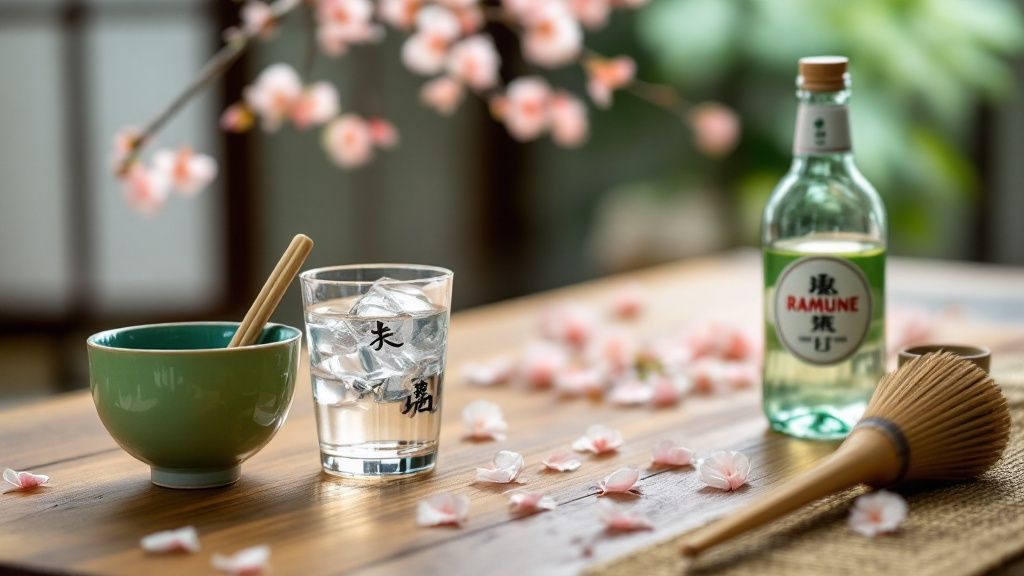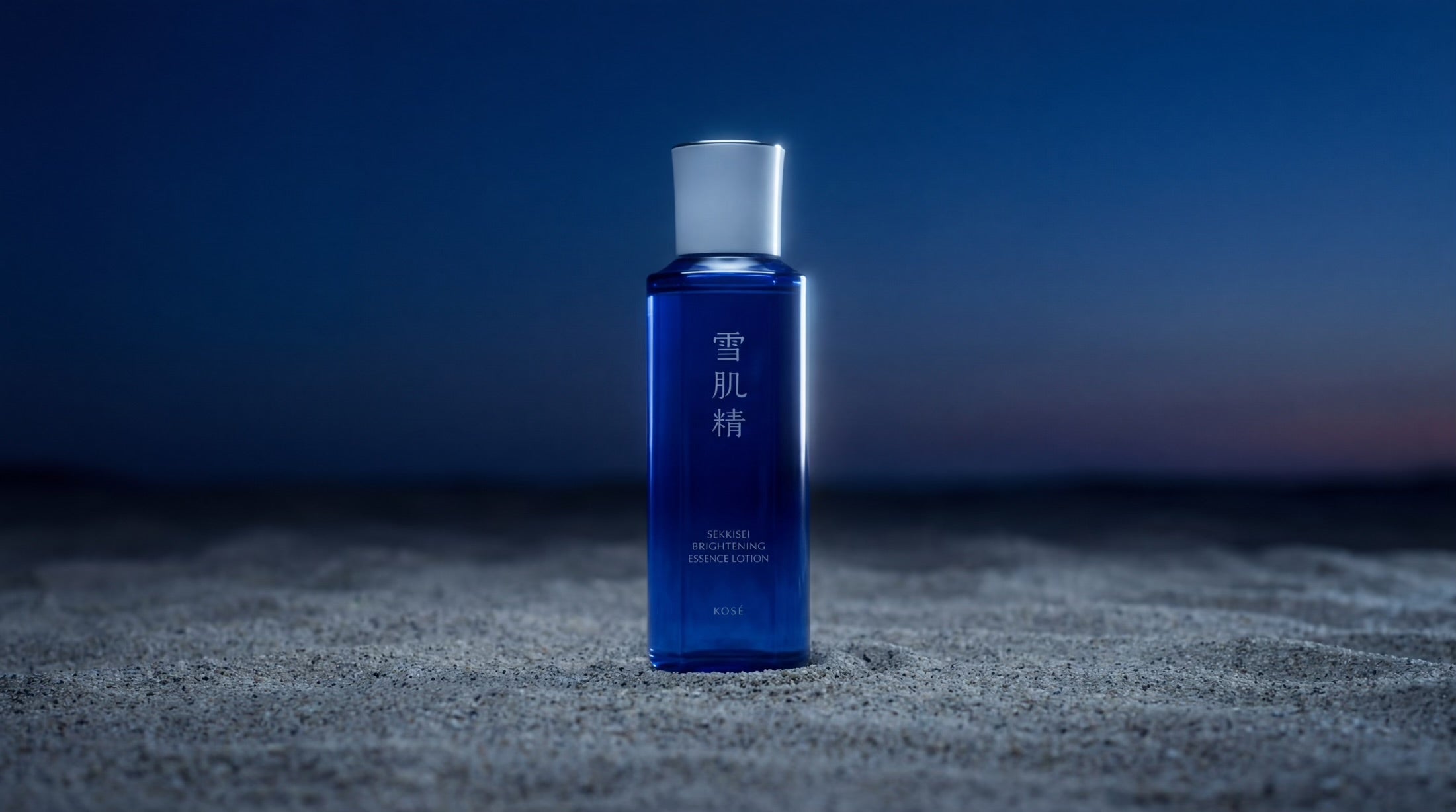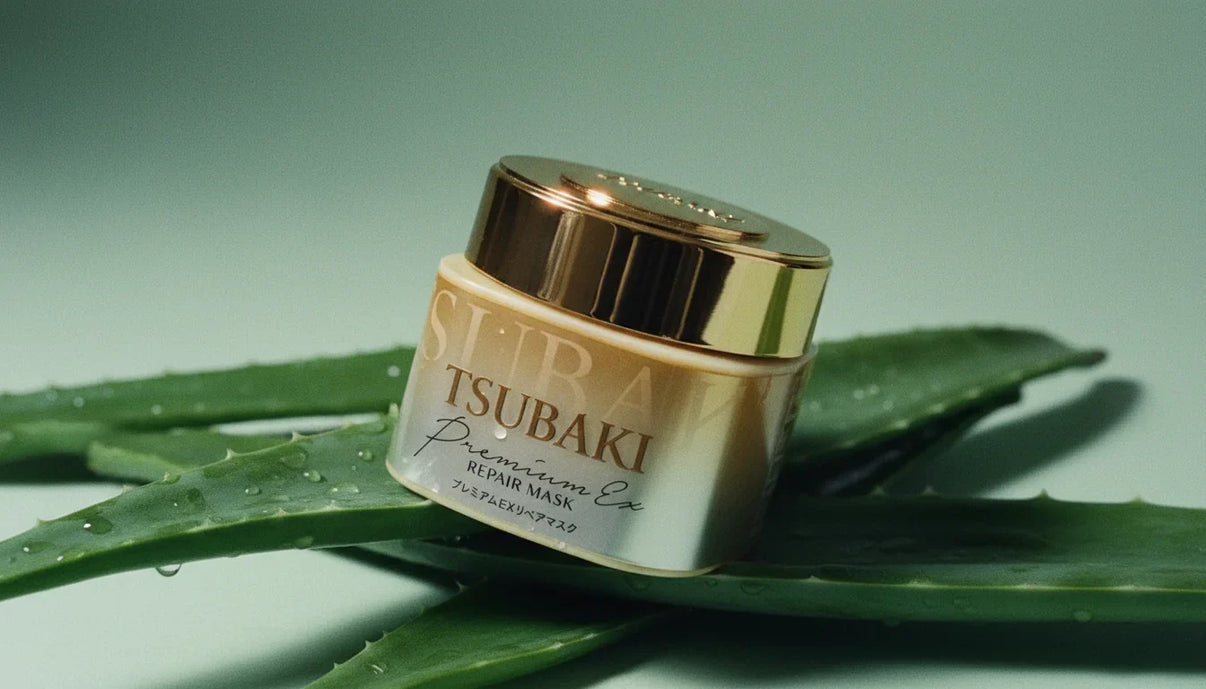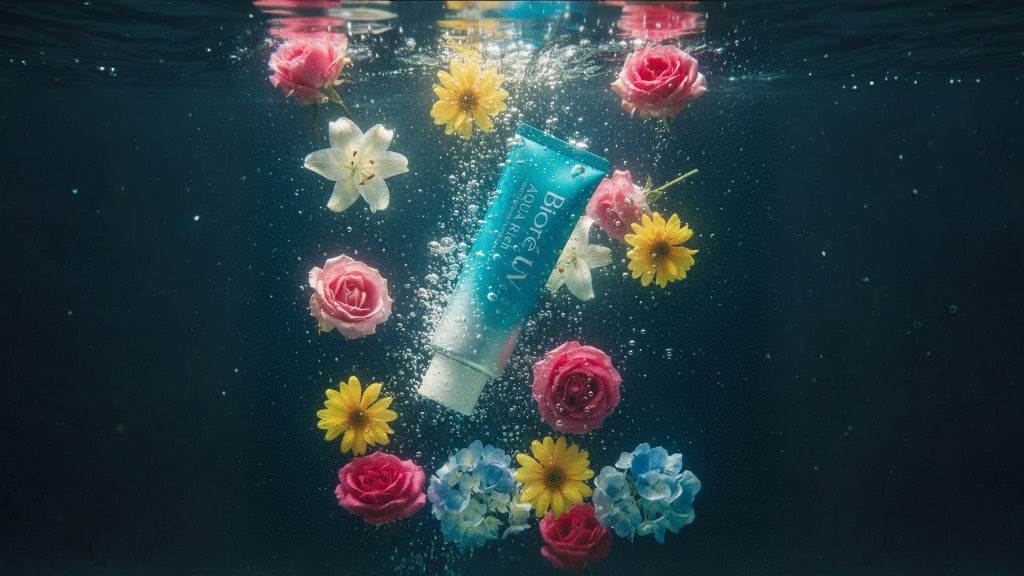Mitä mieleesi tulee japanilaisista juomista? Monille se on seremoniallisten teelaatujen muinainen perinne tai hienostunut Sake-juoman maku. Mutta Japanin juomamaailma on kiehtova kokonaisuus, joka yhdistää vuosisatojen perinteen moderniin, omalaatuiseen hauskuuteen. Suosituin japanilainen juoma riippuu hetkestä—juhlitaanko, rentoudutaanko vai kaivataanko nopeaa piristystä.
Japanilaisten juomien maailman tutkiminen
Valmistaudu sukeltamaan japanilaisten juomien rikkaaseen ja monipuoliseen maailmaan. Kyse ei ole pelkästään pullon sisällöstä; se on matka kulttuuriin, jota muovaavat maantiede, historia ja uskomaton innovointikyky. Tutustumme kaikkeen rauhallisesta, tietoisuutta herättävästä vihreän teen nauttimisesta kylmän Ramune-limsan kuplintaan, kaikki saatavilla juuri täällä kuratoidussa kokoelmassamme.
Japani osaa luoda juoman jokaiseen mahdolliseen mielialaan ja tilanteeseen. Auttaaksemme sinua löytämään uuden suosikkisi olemme koonneet kätevän taulukon. Se on nopea katsaus suosituimpiin vaihtoehtoihimme. Jos haluat syventyä vielä enemmän, tutustu kattavaan oppaaseemme kymmenestä suosituimmasta japanilaisesta juomasta.
Nopea opas suosittuihin japanilaisiin juomiin
Tämä taulukko on lähtökohtasi, nopea yhteenveto parhaista japanilaisista juomista, jotka löydät kokoelmastamme. Ajattele sitä ruokalistana, joka herättää ruokahalusi ennen kuin sukellamme jokaiseen kategoriaan.
| Juomakategoria | Keskeiset ominaisuudet | Parhaiten nautittuna |
|---|---|---|
| Sake (riisiviini) | Vaihtelee kuivasta ja raikkaasta makeaan ja aromaattiseen. | Illallisia, juhlia ja virallisia tilaisuuksia. |
| Japanilaiset teet | Ruohoisia, pähkinäisiä tai paahdettuja makuja. Vähän kofeiinia. | Päivittäistä rentoutumista, meditaatiota tai sosiaalisia hetkiä. |
| Pehmeät & tölkitetyt juomat | Hauskoja, makeita ja usein kuplivia. Ainutlaatuisia makuja. | Rentoa virkistystä ja nautintoa liikkeellä ollessa. |
| Energiajuomat | Suunniteltu nopeaan piristykseen. Ainutlaatuiset ainesosat. | Ennen treeniä, pitkiä työpäiviä tai opiskelusessioita. |
Jokainen kategoria tarjoaa ainutlaatuisen maun japanilaiseen kulttuuriin, huolellisesti valmistetuista teelaaduista, jotka rauhoittavat sielua, aina energisiin juomiin, jotka pitävät yllä vilkasta nykyaikaista elämää. Tutustutaan siihen, mikä tekee jokaisesta niin erityisen.
Sake: Japanilainen riisiviini parhaimmillaan
Kun ajattelet japanilaisia juomia, sake on todennäköisesti ensimmäinen mieleesi tuleva asia. Se on paljon enemmän kuin pelkkä alkoholijuoma; se on todellinen kulttuurinen kulmakivi, jonka tarina ulottuu vuosisatojen taakse. Japanissa sitä kutsutaan nimellä Nihonshu, ja se on kudottu osaksi jokapäiväistä elämää, pyhistä seremonioista vilkkaisiin juhliin.
Unohda mielikuvasi kovista väkevästä. Meidän valikoimamme laadukas sake on lähempänä hienoa viiniä, tarjoten valtavan makujen kirjon, joka voi olla uskomattoman monimutkainen ja kauniin hienovarainen.
Saken valmistuksen taito on japanilaisen tarkkuuden mestarikurssi, jonka historia ulottuu yli 1 000 vuoden taakse Naran kaudelle (710-794 jKr). Vaikka sen suosio Japanissa on vaihdellut, sen maailmanlaajuinen vetovoima on ollut vahvempaa kuin koskaan. Japanilaiset saken vientimäärät ovat kasvaneet tasaisesti, saavuttaen ennätyksellisen noin 40 000 kilolitraa vuonna 2022—se on lähes 50 % nousu vain kymmenessä vuodessa! Voit tutustua lisää tähän dataan Japanin alkoholimarkkinoiden trendeistä Statista.comissa.
Saken luokitusten ymmärtäminen
Sake-maailmaan sukeltaminen voi aluksi tuntua hieman pelottavalta, mutta se todella tiivistyy muutamaan keskeiseen termiin. Tärkeimmät luokitukset perustuvat riisin kiillotusasteeseen, joka tarkoittaa yksinkertaisesti sitä, kuinka paljon riisin jyvän ulkokerroksesta on jauhettu pois ennen käymistä.
Ajattele sitä näin: mitä enemmän riisiä kiillotetaan, sitä enemmän päästään jyvän puhtaaseen, tärkkelyspitoiseen ytimeen. Tämä luo yleensä hienostuneemman, aromaattisemman ja premium-tason saken. Alhaisempi luku tarkoittaa enemmän kiillotusta.
Tässä ovat päätyypit, joita kohtaat kokoelmassamme:
- Junmai: Tämä on puhdasta riisisakea. Se valmistetaan vain neljällä ainesosalla: riisi, vesi, hiiva ja koji-home. Lisättyä tislaajaviinaa ei ole, mikä yleensä antaa sille rikkaan, täyteläisen maun.
- Ginjo: Premium-laatu, jossa vähintään 40% riisin jyvästä on kiillotettu pois. Tuloksena on tyypillisesti kevyempi, aromaattisempi ja usein hedelmäinen juoma.
- Daiginjo: Tämä on superpremium-tavaraa. Vähintään 50% riisistä on jauhettu pois, mikä tuottaa sakea, joka tunnetaan uskomattoman pehmeänä, aromaattisena ja monimutkaisena.
Joten kun näet pullon kuten meidän Gekkeikan Horin Junmai Daiginjo, tuo "Junmai Daiginjo" -merkintä kertoo kaiken. Se on huippuluokan, puhdas riisisake. Tässä on herkkä, hedelmäinen profiili, jossa on melonin ja hunajamelonin vivahteita—täydellinen kumppani kevyemmille ruoille kuten sushille tai grillatulle kalalle. Kun opit nämä luokitukset, löydät täydellisen pullon joka tilanteeseen.
Japanilaisten teelaatujen taide ja rituaali

Vaikka sake saattaa olla juhlan sielu, japanilainen tee on Japanin arjen sydän. Se on paljon enemmän kuin pelkkä juoma; se on hiljainen hetki, tervetulon merkki ja todella hienostunut taidemuoto. Japanilaisen teen maailma on uskomattoman monipuolinen, ulottuen kauas tunnetusta matchasta koko makujen kirjoon, jota muokkaavat ainutlaatuiset viljely- ja käsittelymenetelmät.
Kaiken ytimessä on japanilainen teeseremonia, joka tunnetaan nimellä Chanoyu, eli "teen tie." Syvälle zenbuddhalaisuuteen juurtunut kaunis rituaali muuttaa teen valmistamisen ja tarjoilun yksinkertaisen teon meditaatioksi, joka keskittyy harmoniaan ja kunnioitukseen. Se on täydellinen ikkuna siihen, kuinka syvästi tee on kudottu Japanin kulttuuriseen kudokseen.
Matcha-kulhon ulkopuolella
Matcha saa paljon huomiota seremoniallisesta roolistaan, mutta on olemassa useita muita teelaatuja, jotka ovat ehdottomia perusjuomia japanilaisissa kodeissa. Jokainen tarjoaa täysin erilaisen kokemuksen, raikkaasta ja ruohoisesta ihanan paahteiseen. Kokoelmamme on tarkoitettu tuomaan nämä aidot maut suoraan sinulle.
Ajattele japanilaisia vihreitä teitä kuin sisarussarjaa. Ne kaikki tulevat samasta kasvista, Camellia sinensis, mutta niiden ainutlaatuiset persoonallisuudet – niiden maut – muotoutuvat sen mukaan, miten niitä kasvatetaan ja käsitellään sadonkorjuun jälkeen. Kasvien varjostaminen tai lehtien paahtaminen luo täysin erilaisia tuloksia.
Tässä muutama suosikki, jotka voit löytää sivustoltamme:
- Sencha: Tämä on suosituin ja laajimmin nautittu tee koko Japanissa. Sen lehdet höyrytetään heti poiminnan jälkeen hapettumisen estämiseksi. Tämä yksinkertainen vaihe lukitsee kirkkaan vihreän värin ja tarjoaa raikkaan, hieman ruohoisen maun, jossa on vain ripaus makeutta.
- Hojicha: Hojichan valmistuksessa käytetään Sencha- tai muita vihreän teen lehtiä, jotka paahdetaan hiilillä. Tämä prosessi muuttaa teen, antaen sille punertavanruskean värin ja fantastisen pähkinäisen, paahteisen aromin. Parasta on, että siinä on lähes ei lainkaan katkeruutta ja hyvin vähän kofeiinia.
- Genmaicha: Todella ainutlaatuinen sekoitus, joka yhdistää vihreän teen lehdet paahdettuun ruskeaan riisiin. Riisi lisää suolaisen, pähkinäisen luonteen, joka tasapainottaa kauniisti teen raikkautta, tehden siitä uskomattoman täyteläisen ja lohdullisen kupin.
Näiden erilaisten profiilien tunteminen voi auttaa sinua löytämään täydellisen juoman mihin tahansa mielialaan. Jos haluat sukeltaa vielä syvemmälle, voit oppia lisää oppaastamme japanilaisten teelaatujen tyypeistä.
Modernien japanilaisten virvoitusjuomien tutkiminen

Vaikka perinteisillä teelaaduilla on aina paikkansa, Japanin moderni juomakulttuuri on täysin eri maailma – eloisa leikkikenttä kupliville, hauskoille ja uskomattoman käteville juomille. Nämä virvoitusjuomat ja tölkkikahvit ovat paljon enemmän kuin pelkkiä janonsammuttajia, ja parhaat löydät täältä.
Löydät ne pakattuina jokaiseen lähikaupan jääkaappiin ja hohtamassa jokaisesta automaatista. Ne tarjoavat värikkään kurkistuksen modernin Japanin nopeatahtiseen arkeen.
Ja luvut eivät valehtele. Vuonna 2022 hiilihapotetut virvoitusjuomat olivat kiistaton Japanin alkoholittoman juomamarkkinan kuningas, tuottaen valtavan 22,83 % liikevaihto-osuuden. Voit sukeltaa syvemmälle tietoihin Japanin alkoholittomasta juomamarkkinasta grandviewresearch.comissa nähdäksesi, kuinka suuri ala on.
Ikoniset virvoitusjuomat ja raikkaat maut
Kun ajattelet hauskaa japanilaista limonadia, yksi nimi tulee heti mieleen: Ramune. Se on kuuluisa ainutlaatuisesta Codd-kaulapullostaan, jossa lasikuula täytyy poksauttaa alas avataksesi sen. Tämä yksinkertainen, tyydyttävä poksaus on tehnyt Ramunesta nostalgisen suosikin, erityisesti vilkkaissa kesäjuhlissa.
Ajattele Ramunea japanilaisen kesän äänenä—kuulan poksahtaminen on yhtä ikonista kuin itse limonadin kuplinta. Kokoelmamme sisältää erilaisia Ramune-makuja, klassisesta sitruuna-limestä mansikkaan, valmiina sinua varten.
Toinen rakastettu klassikko, jota meillä on varastossa, on Calpis, joka tunnetaan muissa maissa nimellä Calpico. Se on hiilihapoton virvoitusjuoma, jolla on ainutlaatuinen kirpeä, hieman maitomainen maku, hyvin samankaltainen kuin kevyt, juotava jogurtti. Se on uskomattoman virkistävä ja täysin olennainen sekä lapsille että aikuisille.
Tölkkikahvin kätevyys
Japanissa tölkkikahvi, eli kan kōhī, ei ole pelkkä juoma; se on instituutio. Se syntyi pitkien työpäivien kulttuurista ja tarpeesta nopeaan energiapiikkiin, ja se on täydellinen mukaan otettava kofeiinilisä. Valikoimamme avulla voit kokea tämän kätevyyden missä tahansa oletkin.
Nämä eivät ole pelkästään tavallisia keitoksia. Valikoimamme on uskomaton:
- Musta kahvi: Puhtaan kahvin ystäville, jotka haluavat vahvan ja suoraviivaisen kahvipiikin.
- Café au Lait: Täydellisen kermaisa ja pehmeä kahvin ja maidon sekoitus.
- Makeutetut lajikkeet: Usein hienovaraisilla, herkullisilla karamelli- tai vaniljasävyillä.
Näiden modernien juomien tutkiminen on loistava tapa saada maku nykypäivän Japanista. Ja samalla kun löydät uusia suosikkeja, saatat haluta tutustua myös oppaaseemme vuoden 2025 kymmenestä parhaasta japanilaisesta teemerkkistä.
Japanilaisten energiajuomien ymmärtäminen

Japanin kuuluisan vaativassa työkulttuurissa energiajuomat, eli genki dorinku, ovat enemmän kuin vain nopea piristys. Ne ovat käytännössä välttämätön työkalu pitkän päivän läpikäymiseen. Tämä juomakategoria on suunniteltu antamaan nopea ja tehokas lisäenergia, jotta jaksat hoitaa aikataulusi haasteet.
Toisin kuin monet länsimaissa yleiset sokeriset, kofeiinipitoiset energiajuomat, japanilaiset versiot usein lähestyvät asiaa eri tavalla. Monet tulevat pienissä, vahvoissa lasipulloissa—kuten meillä varastossa olevat—joiden on tarkoitus juoda yhdellä siemauksella. Kyse on toiminnallisuudesta ja tehokkuudesta.
Ja tämä markkina on valtava. Vuonna 2022 energiajuomat kattoivat noin 15% Japanin koko funktionaalisten juomien markkinasta, arvoltaan satoja miljoonia Yhdysvaltain dollareita. Ala kasvaa edelleen, ja ennusteet lupaavat 5-8% vuosittaista kasvua. Voit tutustua näihin lukuihin tarkemmin katsomalla Japanin energiajuomamarkkinadataa dimensionmarketresearch.com-sivustolla.
Mikä tekee niistä erilaisia
Todellinen salaisuus piilee ainesosissa. Monet kaupassamme olevat kaavat sisältävät huolellisesti valittuja komponentteja, joilla on syvät juuret perinteisissä hyvinvointikäytännöissä. Nämä ainesosat toimivat yhdessä tarjoten kestävää energiaa ja tukien kokonaisvaltaista elinvoimaasi.
Ajattele näitä juomia kohdennettuna tukijärjestelmänä, ei pelkkänä energiapaukuna. Ne pyrkivät lataamaan kehoa hyödyllisillä yhdisteillä, auttaen sinua pysymään terävänä ja keskittyneenä vaativina aikoina.
Johtavat merkit, joita myymme, hyödyntävät uskomattomia ainesosia työn tekemiseen:
- Kuningatarhyytelö: Ravinteikas superruoka, joka tunnetaan voimakkaista elvyttävistä ominaisuuksistaan.
- Ginseng-uutteet: Muinainen yrttilääke, joka on tunnettu väsymyksen torjunnasta ja henkisen kirkkauden parantamisesta.
- B-vitamiinit: Tärkeitä ravintoaineita, kuten B2, B6 ja B12, jotka ovat keskeisiä ruoan muuttamisessa käyttökelpoiseksi energiaksi.
Nämä juomat tarjoavat aidon maun modernista japanilaisesta elämäntyylistä ja sopivat täydellisesti intensiivisiin opiskelusessioihin tai haastaviin työpäiviin. Jos etsit energiaa lisääviä juomia, saatat olla kiinnostunut myös muiden perinteisten juomien luonnollisista hyödyistä. Tutustu artikkeliimme 8 hyötyä matchan juomisesta, jotka sinun tulisi tietää.
Valmiina sukeltamaan japanilaisten juomien uskomattomaan maailmaan? Seuraavan suosikkisi valitseminen kokoelmastamme on helpompaa kuin luulet. Kyse on oikeastaan hetkestä. Suuri juhlaillallinen kaipaa käytännössä premium-tason Junmai Daiginjo sakea, kun taas rauhallinen ilta rentoutumiseen on täydellinen hetki nauttia lämmitetystä Hojicha-teestä.
Kun valintasi saapuvat, pieni huolenpito auttaa säilyttämään niiden aidon maun. Ajattele useimpia sakeja kuin hyvää viiniä—säilytä viileässä, pimeässä paikassa ja laita jääkaappiin avaamisen jälkeen. Teet puolestaan tulee pitää poissa valolta ja kosteudelta. Ilmatiivis säiliö on niiden paras ystävä.
Yksinkertaiset yhdistelmät ja säilytysvinkit
Saadaksesi kokemuksesta todella nautinnollisen, kokeile yksinkertaisia ruokayhdistelmiä. Kaupastamme löytyvän Ramune-juoman raikas kupliva maku sopii erinomaisesti suolaisille välipaloille, kuten riisikekseille. Jos nautit herkistä makeisista, Sencha-vihreän teen puhdas jälkimaku täydentää niitä kauniisti ilman, että se peittää makuja.
Parhaan maun saavuttamiseksi tässä muutama yksinkertainen nyrkkisääntö:
- Sake: Tarjoile viilennettynä. Tämä päästää sen hienovaraiset aromit ja raikkauden oikeuksiinsa.
- Vihreä tee: Käytä kuumaa, mutta ei kiehuvaa vettä. Tavoittele noin 175°F (80°C) välttääksesi kitkeryyden ja saadaksesi pehmeän haudutuksen.
- Virvoitusjuomat: Nauti aina hyvin viilennettynä, yleensä jäiden kanssa, saadaksesi täydellisen raikkaan potkun.
Oikea hoito ja harkittu yhdistäminen voivat muuttaa yksinkertaisen juoman unohtumattomaksi kulttuurikokemukseksi. Kyse on uskomattoman käsityötaidon nauttimisesta, joka on jokaisen pullon ja panimon takana.
Näiden vinkkien seuraaminen auttaa sinua löytämään juomiemme parhaat maut. Ja jos alat tutkia teelaatuja kuten matchaa, tulet hämmästymään niiden monipuolisuudesta. Voit jopa lukea lisää oppaastamme 6 tapaa käyttää matchaa ihon heleyttämiseen vuonna 2025.
Onko Sinulla Kysymyksiä Japanilaisista Juomista?
Sukellatko japanilaisten juomien maailmaan ensimmäistä kertaa? Sinulla on todennäköisesti muutama kysymys. Tässä on nopeita vastauksia yleisimmin kysyttyihin asioihin.
Mikä On Japanin Suosituin Juoma?
Se riippuu todella siitä, mitä etsit! Jos puhumme alkoholijuomista, sake on kiistatta kuuluisin ja kulttuurisesti tärkein. Se on todellinen ikoni.
Alkoholittomista vaihtoehdoista klassisempaa ei ole kuin vihreä tee. Lajikkeet kuten Sencha ovat osa miljoonien päivittäistä elämää. Ja kun puhutaan moderneista virvoitusjuomista, hauskat suosikit kuten kupliva Ramune ja kermaisen jogurttimainen Calpis ovat valtavia hittejä, joita molempia löydät myös kaupastamme.
Eroavatko Japanilaiset Virvoitusjuomat Amerikkalaisista?
Ehdottomasti. Huomaat usein, että japanilaisissa virvoitusjuomissa on paljon hienovaraisempi makeus, käytetään vähemmän sokeria paikallisten makumieltymysten vuoksi. Pelkän colan sijaan makuprofiilit ovat uskomattoman monipuolisia ja jännittäviä—ajattele raikasta melonia, kirkasta yuzu-sitrusta ja makeaa lycheetä. Monet juomat sisältävät myös lisäetuja, kuten lisättyjä vitamiineja.
Et tarvitse mitään erityisiä välineitä aloittaaksesi kokoelmamme juomien nauttimisen. Vaikka perinteiset kupit voivat tehdä siitä enemmän rituaalin kaltaisen, tärkeintä on yksinkertaisesti löytää maut, joihin rakastut.
Tarvitsenko Erityisiä Kuppeja Saken Tai Teen Juomiseen?
Ei lainkaan! Toki sakea perinteisestä ochoko-kupista tai teetä kahvattomasta yunomi-kupista juominen lisää autenttista kokemusta, mutta se ei missään nimessä ole vaatimus.
Itse asiassa yksinkertainen viinilasi toimii kauniisti hyvän saken hienovaraisia aromeja arvostaessa, ja suosikkimukisi on täydellinen kumppani lämpimälle, lohduttavalle kupilliselle Hojichaa.
Valmiina tutkimaan näitä uskomattomia makuja itse? Buy Me Japan tarjoaa uskomattoman valikoiman aitoja japanilaisia juomia, premium-sakesta hauskoihin limuihin ja kaikkeen siltä väliltä. Löydä uusi suosikkisi jo tänään.




Jaa:
Riisistä hehkuun: Syvällinen arvostelu Keana Nadeshiko Riisi Seerumi Voide 30g
Opas vaniljamochi-jäätelöön